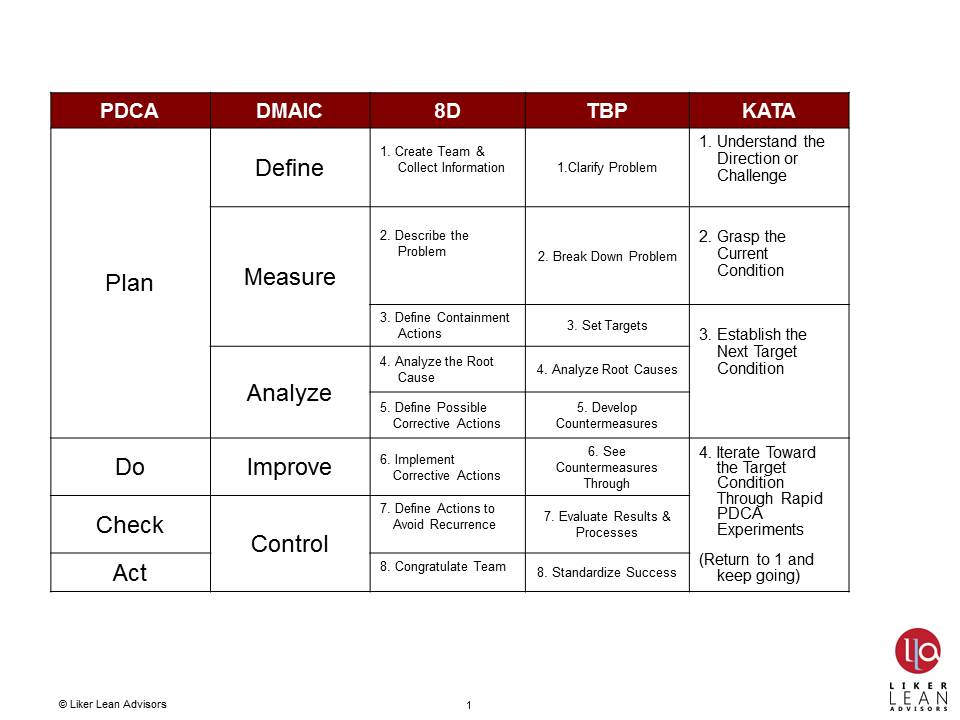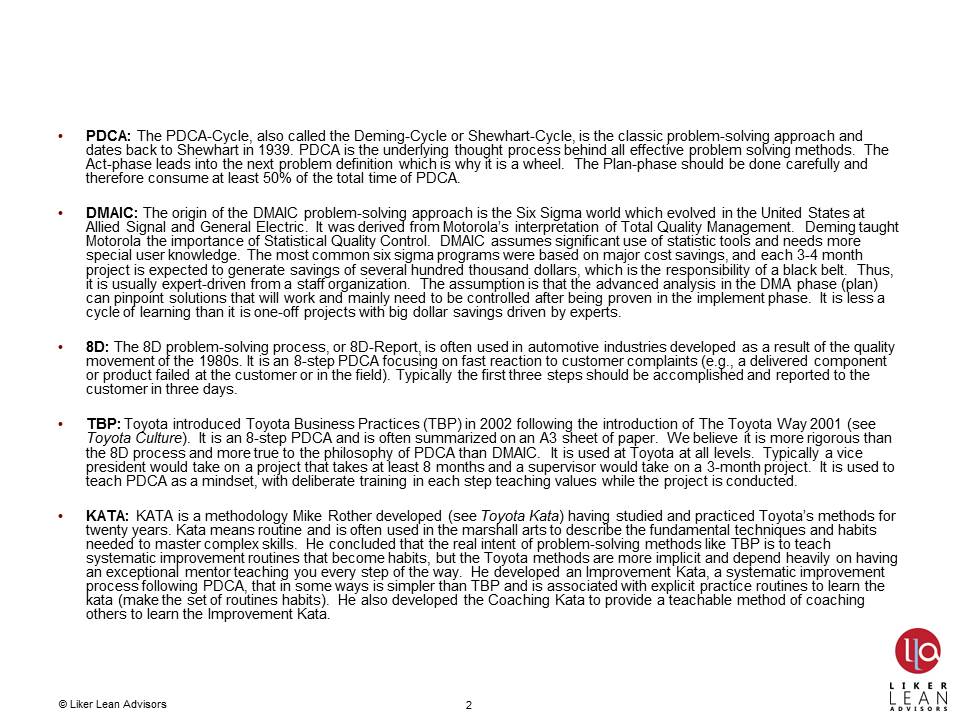Manufacturing Process Improvement Approaches: Are They the Same?
We are deluged with ways to improve our people, processes and technology, including Toyota Business Practices, 8D problem solving, six sigma’s DMAIC, and recently Toyota Kata. When we strip away the acronyms, are they really all that different?

We are deluged with ways to improve our people, processes and technology, including Toyota Business Practices, 8D problem solving, six sigma’s DMAIC, and recently Toyota Kata. When we strip away the acronyms, are they really all that different?
In one sense, the answer is no. Any effective approach to improvement should have the following characteristics:
- Plan — Clearly define the problem and our objectives. This should be expressed as a gap between where we want to be (desired future state) and where we are (current state).
- Plan — Break down this gap into more manageable sub-problems.
- Plan — Try to understand what prevents us from solving the sub-problems. This can be expressed as finding the root cause, or in Toyota Kata terms, identifying obstacles.
- Plan — Develop a set of alternative countermeasures to be tested.
- Do — Try the countermeasures through experiments. Each countermeasure is viewed as a hypothesis to be supported or refuted.
- Check — Check the results of the experiments.
- Act— Assemble what we have learned to define further action, sustain what is working, and communicate to others what may be useful for their improvement efforts.
This PDCA approach was credited to Dr. Deming, who learned from Dr. Shewhart. A careful look shows that this is the scientific method of discovery dating back thousands of years.
 Table 1: Different Problem-Solving Methods (Developed with Daniela Kudernatsch)
Table 1: Different Problem-Solving Methods (Developed with Daniela Kudernatsch)
 Table 2: Further Explanation of Problem-Solving Methods (Developed with Daniela Kudernatsch)
Table 2: Further Explanation of Problem-Solving Methods (Developed with Daniela Kudernatsch)
In Table 1, we compare a set of methods for improvement as they align with PDCA, and in Table 2, we summarize each of these methods. While they all correspond at some level to the steps of PDCA, there are two important differences:
- What is the purpose? The DMAIC method and 8D as typically practiced focus on solving specific problems to get results. Six sigma programs tend to use DMAIC to get results that can be quantified in dollars saved, whereas the 8D is generally used to quickly solve quality problems. Both TBP and Kata take a broader view of improving virtually any aspect of the business while at the same time developing in people the capability to follow the scientific method of improvement. Thus, TBP and Kata take a longer-term perspective improving toward specific challenging future states.
- Who leads the effort? Black belts lead the effort in six sigma, while engineers or quality specialists often lead 8D. In this sense they follow the old Tayloristic model of separating planning (staff functions think) from doing (management and workers implement what they are told). Both TBP and Kata focus on building a cultural capability of continuous improvement so that managers and team members responsible for “doing” are also learners being taught to systematically improve. This shifts the role of staff experts to coaches developing learners.
There are many methods for solving problems, and the good ones follow the scientific process. However, there are important philosophical differences. Is your organization primarily focused on short-term problem solving or long-term adaptability? For the long term, companies need an army of improvers who are at the processes every day so that they can continually experiment and learn. This requires teaching the entire management team and workforce to think and act scientifically.
Dr. Jeffrey Liker is professor of industrial and operations engineering at the University of Michigan and author of The Toyota Way. He leads Liker Lean Advisors, LLC and his latest book (with Gary Convis) is The Toyota Way to Lean Leadership.
Some opinions expressed in this article may be those of a contributing author and not necessarily Gray Construction.
- Category:
- Industry
- Manufacturing
Some opinions expressed in this article may be those of a contributing author and not necessarily Gray.
Related News & Insights
Advanced Technology
The Opportunities and Challenges of a Second Trump Presidency
Opinion
Advanced Technology, Automation & Controls
Four Use Cases for AI's Growing Role in Manufacturing
Industry
November 25, 2024Data Centers
Gray Expands Reach with Dallas Office
Corporate News
November 14, 2024